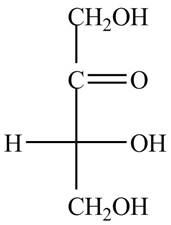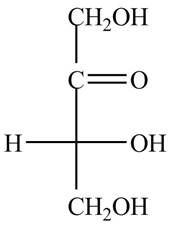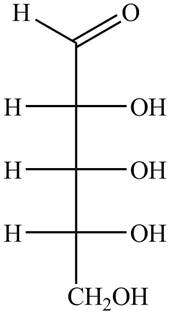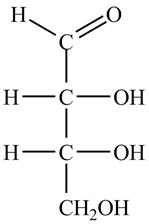
Concept explainers
(a)
Interpretation: The structure of ketotetrose is to be drawn.
Concept introduction: A monosaccharide in which
Answer to Problem 28.1P
The structure of ketotetrose is,

Figure 1
Explanation of Solution
The name ketotetrose suggests that it is a monosaccharide that contains four carbon atoms and a ketone group. The ketone carbonyl group is present on second carbon atom in ketoses. The structure of ketotetrose is shown in Figure 1.

Figure 1
The structure of ketotetrose is shown in Figure 1.
(b)
Interpretation: The structure of aldopentose is to be drawn.
Concept introduction: A monosaccharide in which aldehyde carbonyl group is present at
Answer to Problem 28.1P
The structure of aldopentose is,

Figure 2
Explanation of Solution
The name aldopentose suggests that it is a monosaccharide that contains five carbon atoms and an aldehyde group. The aldehyde carbonyl group is present on first carbon atom in aldoses. The structure of aldopentose is shown in Figure 2.

Figure 2
The structure of aldopentose is shown in Figure 2.
(c)
Interpretation: The structure of aldotetrose is to be drawn.
Concept introduction: A monosaccharide in which aldehyde carbonyl group is present at
Answer to Problem 28.1P
The structure of aldotetrose is,

Figure 3
Explanation of Solution
The name aldotetrose suggests that it is a monosaccharide that contains four carbon atoms and an aldehyde group. The aldehyde carbonyl group is present on first carbon atom in aldoses. The structure of aldotetrose is shown in Figure 3.

Figure 3
The structure of aldotetrose is shown in Figure 3.
Want to see more full solutions like this?
Chapter 28 Solutions
Package: Loose Leaf for Organic Chemistry with Biological Topics with Connect Access Card
- Please correct answer and don't used hand raitingarrow_forwardQ1: Curved Arrows, Bronsted Acids & Bases, Lewis Acids & Bases Considering the following reactions: a) Predict the products to complete the reactions. b) Use curved electron-pushing arrows to show the mechanism for the reaction in the forward direction. Redraw some of the compounds to explicitly illustrate all bonds that are broken and all bonds that are formed. c) Label Bronsted acids and bases in the left side of the reactions. Label conjugate acids and bases in the right side of the reactions. d) Label Lewis acids and bases, nucleophiles and electrophiles in the left side of the reactions. A. + OH CH30: OH B. + HBr C. H₂SO4 D. CF 3. CH 3 + HCI N H fluoxetine antidepressant 1↓ JDownloadarrow_forwardDon't used Ai solutionarrow_forward
- Part 3: AHm,system Mass of 1.00 M HCI Vol. of 1.00 M HCI Mass of NaOH(s) Total Mass in Calorimeter Mole product if HCI limiting reactant Trial 1 62.4009 1.511g Mole product if NaOH limiting reactant Limiting reactant Initial Temperature Final Temperature 23.8°C 37.6°C Change in Temperature AHm,system (calculated) Average AHm,system (calculated) (calculated) (calculated) Trial 2 64.006g 1.9599 (calculated) (calculated) (calculated) (calculated) (calculated) (calculated) 24.7°C 41.9°C (calculated) (calculated) (2 pts. each)arrow_forwardDon't used Ai solutionarrow_forwardWhat is the numerical value of the slope using the equation y=-1.823x -0.0162 please show calculationsarrow_forward
- Don't used hand raitingarrow_forward1.) Using the graph below (including the line equation of y = -1.823x - 0.0162) What is the numerical value for the slope shown? 2.) What are the Unit(s) associated with the slope of the line shown? for we all remember that numerical data always has units. 3.) What would be a good title for this graph and explain your choice. 0.00 0.0 02 0.4 10.6 08 10 12 -0.20 -0.40 -0.60 -0.80 Temp, freezing, in degrees Celcius 5-1.00 -1.20 -1.40 -1:60 y=-1.823x-0.0162 -180 -2.00 Concentration of Sucrose (m)arrow_forwardDon't used Ai solutionarrow_forward
- Identify the Functional Groups (FG) in the following molecules. Classify C atoms as tertiary, 30, or quaternary 40. Identify secondary 20 and tertiary, 30 hydrogen atoms. Please provide steps to undertand each labeling. Please label in the image, so it fits explanation. I am still very unsure I undertand this.arrow_forwardDon't used Ai solutionarrow_forwardDon't used Ai solutionarrow_forward
 Chemistry: Principles and PracticeChemistryISBN:9780534420123Author:Daniel L. Reger, Scott R. Goode, David W. Ball, Edward MercerPublisher:Cengage Learning
Chemistry: Principles and PracticeChemistryISBN:9780534420123Author:Daniel L. Reger, Scott R. Goode, David W. Ball, Edward MercerPublisher:Cengage Learning Introductory Chemistry: A FoundationChemistryISBN:9781337399425Author:Steven S. Zumdahl, Donald J. DeCostePublisher:Cengage Learning
Introductory Chemistry: A FoundationChemistryISBN:9781337399425Author:Steven S. Zumdahl, Donald J. DeCostePublisher:Cengage Learning Chemistry for Today: General, Organic, and Bioche...ChemistryISBN:9781305960060Author:Spencer L. Seager, Michael R. Slabaugh, Maren S. HansenPublisher:Cengage Learning
Chemistry for Today: General, Organic, and Bioche...ChemistryISBN:9781305960060Author:Spencer L. Seager, Michael R. Slabaugh, Maren S. HansenPublisher:Cengage Learning Introductory Chemistry: An Active Learning Approa...ChemistryISBN:9781305079250Author:Mark S. Cracolice, Ed PetersPublisher:Cengage Learning
Introductory Chemistry: An Active Learning Approa...ChemistryISBN:9781305079250Author:Mark S. Cracolice, Ed PetersPublisher:Cengage Learning General, Organic, and Biological ChemistryChemistryISBN:9781285853918Author:H. Stephen StokerPublisher:Cengage Learning
General, Organic, and Biological ChemistryChemistryISBN:9781285853918Author:H. Stephen StokerPublisher:Cengage Learning Organic And Biological ChemistryChemistryISBN:9781305081079Author:STOKER, H. Stephen (howard Stephen)Publisher:Cengage Learning,
Organic And Biological ChemistryChemistryISBN:9781305081079Author:STOKER, H. Stephen (howard Stephen)Publisher:Cengage Learning,





